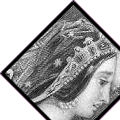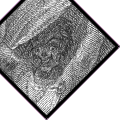





Bennet, Paula. Emily Dickinson, Woman Poet. U of Iowa, 1990.
"When imagining her speaker in love with a man, Dickinson was apparently unable to conceive of relationship (or a language in which to express it) that did not conform to heterosexuality's cultural inscription. Women were smaller, weaker, and less empowered than men . . . While the depiction of this state of dependency could result in poems of great and even tender passion, as in "He touched me, so I live to know" (#506), it was rooted in the acceptance of female lack" (159-60).
Capps, Jack L. Emily Dickinson's Reading, 1836-1886. Cambridge: Harvard UP, 1966.
Capps notes that Dickinson read Thomas Moore's The Epicurean when she came home sick from Mount Holyoke, as well as Longfellow's Evangeline, Tennyson's The Princess, and Marcella Smedley's The Maiden Aunt (17). According to Capp, Austin owned a copy of Lalla Rookh.
Christy, Arthur. "The Orientalism of Whittier" American Literature 5.3. (Nov 1933): 247-257.
Edwards, Holly, ed. Noble Dreams, Wicked Pleasures: Orientalism in America, 1870-1930. Princeton: Princeton UP, 2000.
Farr, Judith. The Passion of Emily Dickinson. Boston: Harvard UP, 1992.
Farr reads "He touched me" in light of what she calls "the narrative of master"--a reference to the "Master" poems that some scholars consider suggestive of Dickinson's passion for a man, perhaps Bowles (238). Farr finds in the first stanza an "awed vision of Master" and she suggests that since Dickinson would hide herself behind a door during Bowles's visits, she might well feel a kinship with Rebecca since the latter covered herself with a veil when she saw Isaac, her master. Farr admits that the "yoking" together of two images--Rebecca and the baffled Persian--is "unexpected," but she suggests that both speak of frustrated desire.
Finkelstein, Dorothee, Melville's Orienda. New Haven: YaleUP, 1961.
See for orientalism in first half of 19th c. in the U.S.
Isani, Mukhtar Ali. "Zoroastrianism and the Fire Symbolism in Moby-Dick," American Literature, Vol.44, No. 3. (Nov., 1972), pp. 385-397.
Isani traces orientialism in the U.S. See p. 386 and note 5 for commentary on Lalla Rookh and Moore's Zoroastrian hero.
Leask, Nigel. British Romantic Writers and the East: Anxietiesof Empire. Cambridge: Cambridge UP, 1992.
While the study focuses on oriental texts by Bryon, Shelley, De Quincey and Coleridge,Moore's Lalla Rookh earns some commentary. Leask reads Moore's oriental romance in the tradition of British orientalism that frequently depicted failed revolutions in the east. In "The Veiled Prophet of Khorassan," the first section of Lalla Rookh, Azim, the hero, is duped into joining a revolt against Islam led by the evil Mokanna who enslaves in his opulent harem Azim's beloved Zelica. Belatedly, Azim realizes that the ideals of liberty of ancient Greece are not the motivation of Mokanna, and Azim switches his loyalties to the counter-revolutionary Caliph. In "The Fire-worshippers," a second tale in Lalla Rookh, Moore again describes an unsuccessful revolt and a tragic love affair. Moore admitted, "I should not be surprised if this story of the Fire-worshippers were found capable of a . . . doubleness of application" (qtd. in Leask,113). Leask suggests that Moore resists the reforms of John Stuart Mill and Percy Byshe Shelly as akin to "Jacobin cosmopolitanism and French atheism, and that, instead, Moore is "sympathetic to the claims of a romantic, organic nationalism" (113). In other words, Moore's sympathies for the Zoroastrians in their struggle against their Islamic conquerors can be read as his loyalty to Ireland against the colonial oppression of the English, and to Catholicism against the forces of Protestantism. More generally, Leask notes the literary profits that Bryon and Moore found in orientalism. In 1813, Byron wrote to Moore, encouraging him to "Stick to the East . . . The North, South, and West, have all been exhausted. . . the public are orientalizing . . . " (qtd. in Leask, 13). Between 1813 and 1816, Byron became the most popular poet in Britain with his EasternTales, and the publisher Longman, attuned to the popularity of theorient, commissioned Moore's Lalla Rookh for an unprecedented three thousand guineas.
Leask, Nigel. "'Wandering through Eblis'; absorption and containment in Romantic exoticism." Romanticism and Colonialism: Writing andEmpire, 1780-1830. Ed. Tim Fulford and Peter J. Kitson. Cambridge: Cambridge UP, 1998.
Noting the informative footnotes thataccompany Lalla Rookh and other oriental texts of British romanticism,Leask argues that this technique flaunts a kinship with scientific travelnarratives. He suggests that the "totalizing project revealed bythese footnotes and the depth of ethnographic details which they underwrite"represent a new romantic aesthetic. The affect of this aestheticis to make sure that "the absorptive pull of the exotic visual image orallusion" is "constantly checked and qualified by a globalizing, descriptivediscourse which draws the viewer/reader away from dangerous proximity tothe image, in order to inscribe him/her in a position of epistemologicalpower; nothing other than the commanding vision of imperialist objectivity"(168). may well be a vestige of the Renaissance notion of epicas a compendium of universal science."
Patterson, Rebecca.
Patterson notes that Susan and Emily were attentive to news accounts of Sir John Franklin's failed efforts to discover a Northwest passage to the Orient. They named a drafty hallway where they met the "Northwest passage" (91). She also notes that Susan owned an 1860 anthology of poetry that included a selection from Lalla Rookh, and that in "the Dickinson copy of Lalla Rookh three passages dealing with the pleasures, pangs, and disillusionments of love are marked in what seems to be the poet's usual fashion" (158). Patterson's reading of "He touched me" notes Moore's poem as a possible source. Patterson calls the poem "confused" and suggests that in this poem Emily Dickinson compares "her own idolatrous passion with that of a 'Persion' girl who turns away, baffled, from her 'shrine,' to life up a 'Crucifixal sign' toward her adored 'imperial Sun.'" According to Patterson, Dickinson is both the "Persion burning in the sacred fire and the appalled onlooker at her own immolation."
Makdisi, Saree. Romantic Imperialism: Universal Empire andthe Culture of Modernity. Cambridge: Cambridge UP, 1998.
Makdisi offers no comments on Moore or Lalla Rookh, but this study makes an important contribution to our understanding of orientalism--the creation of a place, a people, and a culture in the literary imagination that had deep and complex relations with the fact that "between 1790 and1830 more than one hundred and fifty million people were brought under British imperial control" (xi).
Said, Edward. Orientalism. New York: Random, 1978.
Sharafuddin, Mohammed. Islam and Romantic Orientalism: LiteraryEncounters with the Orient. London: Tauris, 1994.
Sharafuddin suggests, in contrast to Edward Said, that East is not represented only in stereotypic images of tyranny, exoticism, immorality, and unreason. In Lalla Rookh, Sharafuddin believes Moore makes visible and even appealing that part of Islam that offended Christian prejudices--religious, political and erotic fanaticism.
Whalen, Terence. "Edgar Allan Poe and the Horrid Laws of Political Economy," American Quarterly, Vol.44, No. 3. (Sep., 1992), pp. 381-417
George Landow, "Orientalism: a Brief Definition"
This page quotes several paragraphs from the fist few pages of Edward Said's Orientalism.
A comprehensive site by Landow and his students on Said and his work.
This page from an Emory University site on postcolonialism summarizes Edward Said's Orientalism.
Noble Dreams, Wicked Pleasures: Orientalism in America, 1870-1930, Article 1 and Article 2
Both of these links feature excellent articles about a travelling exhibit "Noble Dreams, Wicked Pleasures: Orientalism in America, 1870-1930" organized by the Sterling and Francine Clark Art Institute.
Critical Issues | Student Projects | Bibliography



